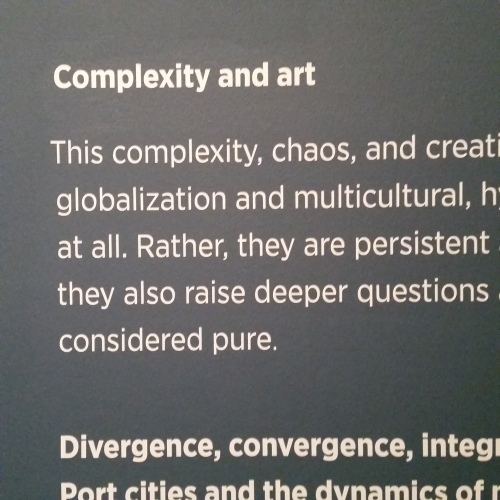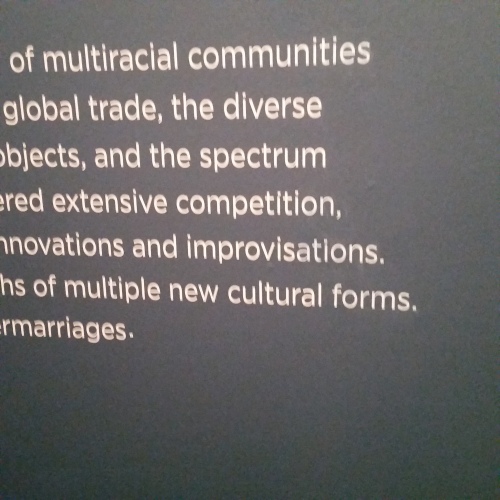http://acm.org.sg/exhibitions/port-cities is ACM’s new exhibition that recently-opened to much fanfare. In his own site, Director Kenny said “The exhibition is also significant because the concept and the curatorial narrative of the exhibition originated in ACM, and it is the first exhibition anywhere in the world that adopts a pan-Asian approach in presenting on the subject of Port Cities in Asia”. Curiously, the show is curated by an external curator who is not known for much beyond Peranakan exhibitions; why use him for this new, wide topic for which he is relatively unknown, when ACM already has existing cross-culture curators? Perhaps ACM still owes him favours for a large donation his parents gave to the museum, as mentioned in a previous post here on the Lee Kip Lee/Peter Lee/Peranakan Museum links?? But anyway…
Well, before visiting the exhibition, there’s lots to be excited about. 1) ACM has always been a pan-Asian museum, and it is expected that this new pan-Asian exhibition will be covering new ground. 2) There’s a new director who is excited about pan-Asian-ness, and together with the new-ish cross-culture curators at ACM, this exhibition should be good. 3) I saw in the museum shop on the way into the exhibition that the catalogue features the doyens of Asian history – the Andayas – as contributors to an article, and this was a good sign. And of course 4) because I had to pay $13 for the exhibition (when otherwise most other exhibitions are free), it’d better be good enough to justify the infinite chasm between free and not.
So I stepped into the exhibition, anticipating quite a bit. Why wouldn’t I? Think about it, Port Cities in Asia. There must be 100s if not 1000s of such port cities, spanning Middle-East to the west and Japan to the east, the east-west coasts of India, and 1000s of km of beaches in Malaysia, Indonesia, Vietnam, Cambodia and Philippines. Some are probably 1000s of years old, while most at least have a few centuries of histories (like the 1500-1900 suggested in the title). There must be so many similarities as well as differences between these ports across Asia.
Imagine all that richness of material culture, and expanse of space and time, all boiled down to a paltry 180 artefacts, squeezed into a space no larger than 1-2 tennis courts. Standing at the end of the exhibition hall, I had to ask a guard if there was another space somewhere else in the museum where the exhibition continued. (His answer was ‘No’)…
There’s no need to do detailed summary of the exhibition lah. The subject title is already quite ambitious for a ‘book’ (or several books), let alone trying to organise an exhibition around it, let alone trying to squash it all into a little shoebox of a space, let alone trying to achieve all that with less than 200 objects. Of course there are huge gaps in the storyline on display – where are the indigenous/tribal peoples who were important in supplying the port cities with trade goods, where are the languages that you hear, the religions practiced, the foods eaten, what about the changes that EACH port city has gone through in its lifetime, let alone the webs of change that all the inter-linked port cities had endured, where are the internal and external wars, and where the heck were all the stuff that were traded, from spices to horns to wood to textiles etc – leaving a few cheesy-looking pieces of clothing (they look more like theatrical props than bone fide artifacts) taking up most of the front-displays and some mute wooden chairs bringing up the rear.
And all this rosiness pushing the notion that port-cities are warm, fuzzy marketplaces where people hang around peacefully and make friends and exchange ideas is shockingly simplistic. Beyond the one print of the 1740 Batavia massacre of 1000s of Chinese settlers, there is almost no mention that port cities are rosy one day and horror stories the next. Countless lives were lost to invaders/conquerors/rebels/pirates both local and foreign, and even more must have perished due to the introduction of new diseases from lands faraway and those resulting from unsanitary living conditions that cities brought. And to cite a bit more of academic discourse, a colonial officer in Burma – Furnivall – already pointed out that in such colonised societies, the pluralities of peoples mixed for business but did not combine socially; so beyond the hustle and bustle of port cities, we need to problematise the oversimplification that the ‘combination’ of racial/ethnic/cultural differences was the norm.
I’m a tad embarrassed that I have to be this blunt. ACM used to have vision (of scope) and reality (of what objects can be displayed to prop up a storyline) pretty well matched. But now, even though you have opened a few new swanky galleries and now a new exhibition (and soon another new one on Myanmar in Dec 2016), I think your storylines are better read in books than seen in actual displays. In museum-speak, for the Port Cities exhibition, you have bitten off way more than your little mouth can masticate: The gargantuan storyline-breadth (impressive as it may be) is way more ambitious than the feeble number of artifacts that you can rustle up in its justification. Anyone can tell a story in a book (because words are cheap), but a museum must always rely on objects to make tangible an intangible storyline.
You know what? In hindsight, the exhibition feels like it is the much smaller, humbler supporting act to the main event, which was the publishing of the book, rather than the exhibtion being the main event and the book the supporting act. Oh, and if the book is indeed the main event, it’s already been done before… see this link here of the book “Asian Port Cities, 1600-1800“.
Director Kenny, about the $13 I paid for the ticket…


